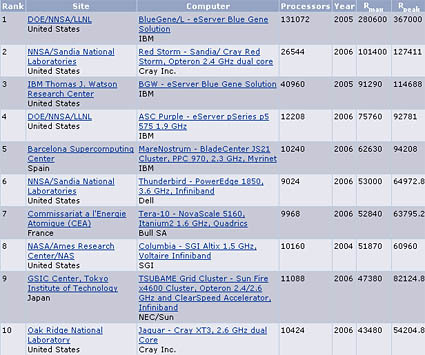AMD's Opteron shows muscles in supercomputer list
Berkeley (CA) - The 28th list of the world's 500 most power supercomputers was published one day ahead of the official opening of the SC06 supercomputing conference. The top-10 of the list saw major changes, partially due to three new AMD Opteron systems, which are ranked in Position 2, 9 and 10.
The recent trend of rapidly increasing computing performance among supercomputers continued in this year's fall list. To get into the list system need to post a performance of at least 2.734 TFlops - a value that was enough to boost a supercomputer to position 23 just three years ago. To be listed on rank 100, a system must report 6.65 TFLOPs, which would have been enough for a Top-10 spot in 2003.
While the Top-500 list has seen an overall 56% increase in supercomputing performance, it is the top-10 that has been impacted by the most dramatic changes. Position 1 is still held by the U.S. Department of Energy's BlueGene/L system, which is rated at a peak performance of 367.0 TFlops. The new number 2 is Sandia's Red Storm which achieves a peak performance of 127.4 TFlops and is only the second supercomputer in history to break the 100 TFlop barrier. Red Storm was built by Cray and is based on 13,277 2.4 GHz AMD Opteron dual-core processors.
IBM's new BlueGene came in at position 3, followed by the U.S. Department of Energy's ASC Purple. The Barcelona Supercomputing Center's MareNostrum is ranked fifth, while the Dell-built Thunderbird Xeon-system used by Sandia National Laboratories is Intel's highest ranked supercomputer system.
The Top 10 of the Fall 2006 Top 500 supercomputer list
Another noteworthy entry is the Tsubame grid cluster, which is also based on AMD Opteron processors. The top-10 list was shaken up by a total of seven new supercomputers that were introduced during the current year, which lifted the minimum performance requirement to more than 54 TFlops. Japan's Earth Simulator, which has held the number position of the ranking in the early 2000s and which is considered as one of the main reasons of a renewed focus on supercomputing in the U.S. has slipped to position 14 with a peak performance of not quite 41 TFlops.
AMD, which still a fairly new competitor in server and high performance computing, now has 113 Opteron systems in the Top 500 supercomputer list.
Get Tom's Hardware's best news and in-depth reviews, straight to your inbox.
Tom's Hardware is the leading destination for hardcore computer enthusiasts. We cover everything from processors to 3D printers, single-board computers, SSDs and high-end gaming rigs, empowering readers to make the most of the tech they love, keep up on the latest developments and buy the right gear. Our staff has more than 100 years of combined experience covering news, solving tech problems and reviewing components and systems.


